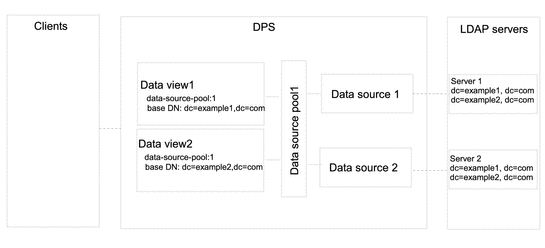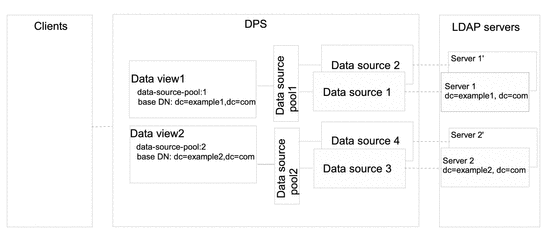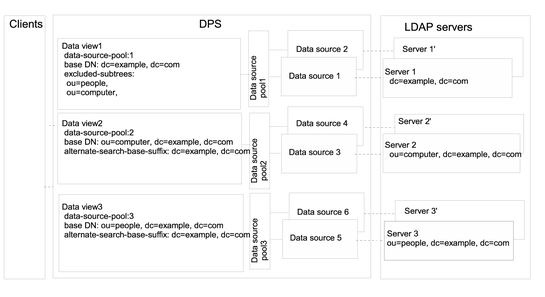Creating and Configuring Data Views for Example Use Cases
This section contains the following information about data views and how to create and configure them:
The examples in this section assume that the connection handler allows all client connections to be processed by Directory Proxy Server.
Default Data View
If you create a data view without configuring any of the properties, your data view has the following configuration:
alternate-search-base-dn : "" alternate-search-base-dn : base-DN attr-name-mappings : none base-dn : suffix-DN contains-shared-entries : - description : - distribution-algorithm : - dn-join-rule : - dn-mapping-attrs : none dn-mapping-source-base-dn : none excluded-subtrees : - filter-join-rule : - is-enabled : true is-read-only : false is-routable : true ldap-data-source-pool : pool-name lexicographic-attrs : all lexicographic-lower-bound : none lexicographic-upper-bound : none non-viewable-attr : - non-writable-attr : - numeric-attrs : all numeric-default-data-view : false numeric-lower-bound : none numeric-upper-bound : none pattern-matching-base-object-search-filter : all pattern-matching-dn-regular-expression : all pattern-matching-one-level-search-filter : all pattern-matching-subtree-search-filter : all process-bind : - replication-role : master viewable-attr : all except non-viewable-attr writable-attr : all except non-writable-attr |
Data Views That Route All Requests, Irrespective of the Target DN of the Request
This section shows the configuration of a data view that routes all requests to a data source pool, irrespective of the target DN of the request. This data view is called the root data view. The root data view is created by default when an instance of Directory Proxy Server is created. For information about the root data view, see Data Views to Route All Requests, Irrespective of the Target DN of the Request in Sun Java System Directory Server Enterprise Edition 6.3 Reference.
The root data view has the following configuration:
alternate-search-base-dn : -
attr-name-mappings : none
base-dn : ""
contains-shared-entries : -
description : Automatically-generated data view
able to route client operations
independently of the operation base dn
distribution-algorithm : -
dn-join-rule : -
dn-mapping-attrs : none
dn-mapping-source-base-dn : none
excluded-subtrees : ""
excluded-subtrees : cn=config
excluded-subtrees : cn=monitor
excluded-subtrees : cn=proxy manager
excluded-subtrees : cn=virtual access controls
excluded-subtrees : dc=example,dc=com
filter-join-rule : -
is-enabled : true
is-read-only : false
is-routable : true
ldap-data-source-pool : defaultDataSourcePool
lexicographic-attrs : all
lexicographic-lower-bound : none
lexicographic-upper-bound : none
non-viewable-attr : -
non-writable-attr : -
numeric-attrs : all
numeric-default-data-view : false
numeric-lower-bound : none
numeric-upper-bound : none
pattern-matching-base-object-search-filter : all
pattern-matching-dn-regular-expression : all
pattern-matching-one-level-search-filter : all
pattern-matching-subtree-search-filter : all
process-bind : -
replication-role : master
viewable-attr : all except non-viewable-attr
writable-attr : all except non-writable-attr
|
Data Views That Route Requests When a List of Subtrees Is Stored on Multiple, Data-Equivalent Data Sources
This section describes how to configure a data view that routes requests targeted at a list of subtrees to a set of data-equivalent data sources. For information about this type of deployment, see Data Views to Route Requests When a List of Subtrees Are Stored on Multiple, Data-Equivalent Data Sources in Sun Java System Directory Server Enterprise Edition 6.3 Reference.
The example in this section has multiple data sources that contain the same set of subtrees. The data sources are data-equivalent and are pooled into one data source pool for load balancing. A data view is configured for each subtree to expose that subtree to client requests. The following figure shows the sample deployment.
Figure 19–1 Sample Deployment That Routes Requests When a List of Subtrees Is Stored on Multiple, Data-Equivalent Data Sources

 To Configure Data Views That Route Requests When a
List of Subtrees Is Stored on Multiple, Data-Equivalent Data Sources
To Configure Data Views That Route Requests When a
List of Subtrees Is Stored on Multiple, Data-Equivalent Data Sources
You can use DSCC to perform this task. For information, see Directory Service Control Center Interface and the DSCC online help.
-
Create a data source for each LDAP server as described in Creating and Configuring LDAP Data Sources.
-
Create a data source pool as described in Creating and Configuring LDAP Data Source Pools.
-
Attach the data sources to the data source pool as described in Attaching LDAP Data Sources to a Data Source Pool.
-
(Optional) Configure load balancing.
For information, see Configuring Load Balancing.
-
Create a data view with a base DN at dc=example1,dc=com that refers to the data source pool.
$ dpconf create-ldap-data-view -h host1 -p 1389 dataview-1 \ data-source-pool-1 dc=example1,dc=com
-
Create another data view with a base DN at dc=example2,dc=com that refers to the data source pool.
$ dpconf create-ldap-data-view -h host1 -p 1389 dataview-2 \ data-source-pool-1 dc=example2,dc=com
The other properties of the data views are the same as the default data view in Default Data View.
-
If necessary, restart the instance of Directory Proxy Server for the changes to take effect.
For information about restarting Directory Proxy Server, see To Restart Directory Proxy Server.
Data Views That Provide a Single Point of Access When Different Subtrees Are Stored in Different Data Sources
This section describes how to configure a data view that provides a single point of access to different subtrees stored in multiple data sources. For information about this type of deployment, see Data Views to Provide a Single Point of Access When Different Subtrees Are Stored on Different Data Sources in Sun Java System Directory Server Enterprise Edition 6.3 Reference.
The example in this section contains a data view for each subtree. A data source pool is configured for each set of data-equivalent data sources. The following figure shows the example deployment.
Figure 19–2 Sample Deployment That Provides a Single Point of Access When Different Subtrees Are Stored on Different Data Sources

 To Configure Data Views That Provide a Single Point
of Access When Different Subtrees Are Stored on Different Data Sources
To Configure Data Views That Provide a Single Point
of Access When Different Subtrees Are Stored on Different Data Sources
You can use DSCC to perform this task. For information, see Directory Service Control Center Interface and the DSCC online help.
-
Create a data source for each LDAP server as described in Creating and Configuring LDAP Data Sources.
-
Create two data source pools as described in Creating and Configuring LDAP Data Source Pools.
-
Attach the data sources that contain dc=example1,dc=com to data-source-pool-1, and the data sources that contain dc=example2,dc=com to data-source-pool-2, as described in Attaching LDAP Data Sources to a Data Source Pool.
-
(Optional) Configure load balancing.
For information, see Configuring Load Balancing.
-
Create a data view with a base DN at dc=example1,dc=com that refers to data-source-pool-1.
$ dpconf create-ldap-data-view -h host1 -p 1389 dataview-1 \ data-source-pool-1 dc=example1,dc=com
-
Create another data view with a base DN at dc=example2,dc=com that refers to data-source-pool-2.
$ dpconf create-ldap-data-view -h host1 -p 1389 dataview-2 \ data-source-pool-1 dc=example2,dc=com
The other properties of the data views are the same as the default data view in Default Data View.
-
If necessary, restart the instance of Directory Proxy Server for the changes to take effect.
For information about restarting Directory Proxy Server, see To Restart Directory Proxy Server.
Data Views That Provide a Single Point of Access When Superior and Subordinate Subtrees Are Stored in Different Data Sources
This section describes how to configure a data view for a single point of access when a superior branch of a subtree is stored in a different data source to a subordinate branch. For information about this type of deployment, see Data Views to Route Requests When Superior and Subordinate Subtrees Are Stored in Different Data Sources in Sun Java System Directory Server Enterprise Edition 6.3 Reference.
The example in this section contains three data views. The base DN of data view 1 is superior to the base DN of data view 2 and the base DN of data view 3. Or, in other words, data source 2 and data source 3 contain subtrees that are subordinate to the subtree on data source 1. The following figure shows the example deployment.
Figure 19–3 Sample Deployment to Routes Requests When Superior and Subordinate Subtrees Are Stored in Different Data Sources

Directory Proxy Server automatically excludes a subordinate branch of a subtree from a data view when the subordinate branch is configured as the base DN of a separate data view.
 To Configure Data Views That Provide a Single Point
of Access When Superior and Subordinate Subtrees Are Stored in Different Data
Sources
To Configure Data Views That Provide a Single Point
of Access When Superior and Subordinate Subtrees Are Stored in Different Data
Sources
You can use DSCC to perform this task. For information, see Directory Service Control Center Interface and the DSCC online help.
-
Create a data source for each LDAP server as described in Creating and Configuring LDAP Data Sources.
-
Create three data source pools as described in Creating and Configuring LDAP Data Source Pools.
-
Attach the data sources to the data source pools by following the instructions in Attaching LDAP Data Sources to a Data Source Pool.
-
Attach the data sources that contain dc=example,dc=com to data-source-pool-1.
-
Attach the data sources that contain ou=computer,dc=example,dc=com to data-source-pool-2.
-
Attach the data sources that contain ou=people,dc=example,dc=com to data-source-pool-3.
-
-
(Optional) Configure load balancing.
For information, see Configuring Load Balancing.
-
Create a data view with a base DN at dc=example,dc=com and a data source pool data-source-pool-1.
$ dpconf create-ldap-data-view -h host1 -p 1389 dataview-1 \ data-source-pool-1 dc=example,dc=com
-
Create a data view with a base DN at ou=computer,dc=example,dc=com and a data source pool data-source-pool-2.
$ dpconf create-ldap-data-view -h host1 -p 1389 dataview-2 \ data-source-pool-2 ou=computer,dc=example,dc=com
-
Create a data view with a base DN at ou=people,dc=example,dc=com and a data source pool data-source-pool-3.
$ dpconf create-ldap-data-view -h host1 -p 1389 dataview-3 \ data-source-pool-3 ou=people,dc=example,dc=com
-
Verify that the subtrees ou=computer,dc=example, dc=com and ou=people,dc=example, dc=com have been excluded from dataview-1 by looking at the excluded-subtrees parameter.
$ dpconf get-ldap-data-view-prop -h host1 -p 1389 dataview-1 excluded-subtrees
The list of excluded subtrees is returned.
-
If necessary, restart the instance of Directory Proxy Server for the changes to take effect.
For information about restarting Directory Proxy Server, see To Restart Directory Proxy Server.
- © 2010, Oracle Corporation and/or its affiliates
